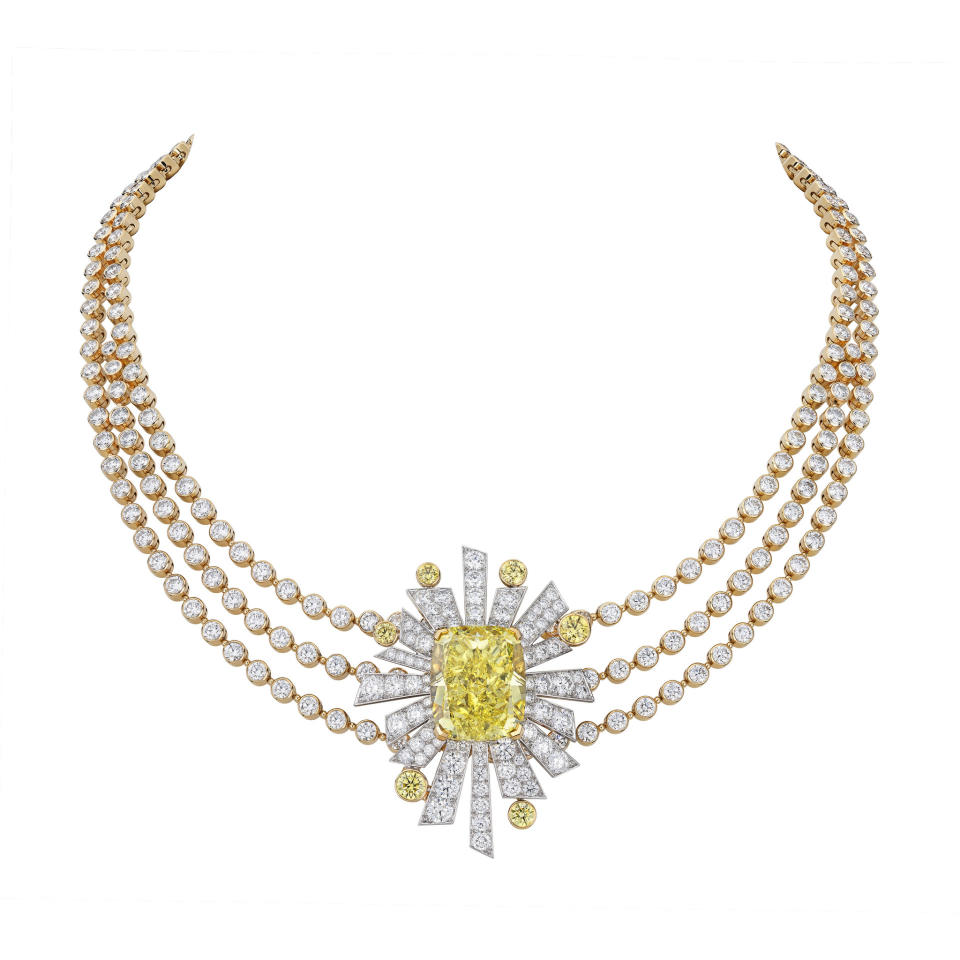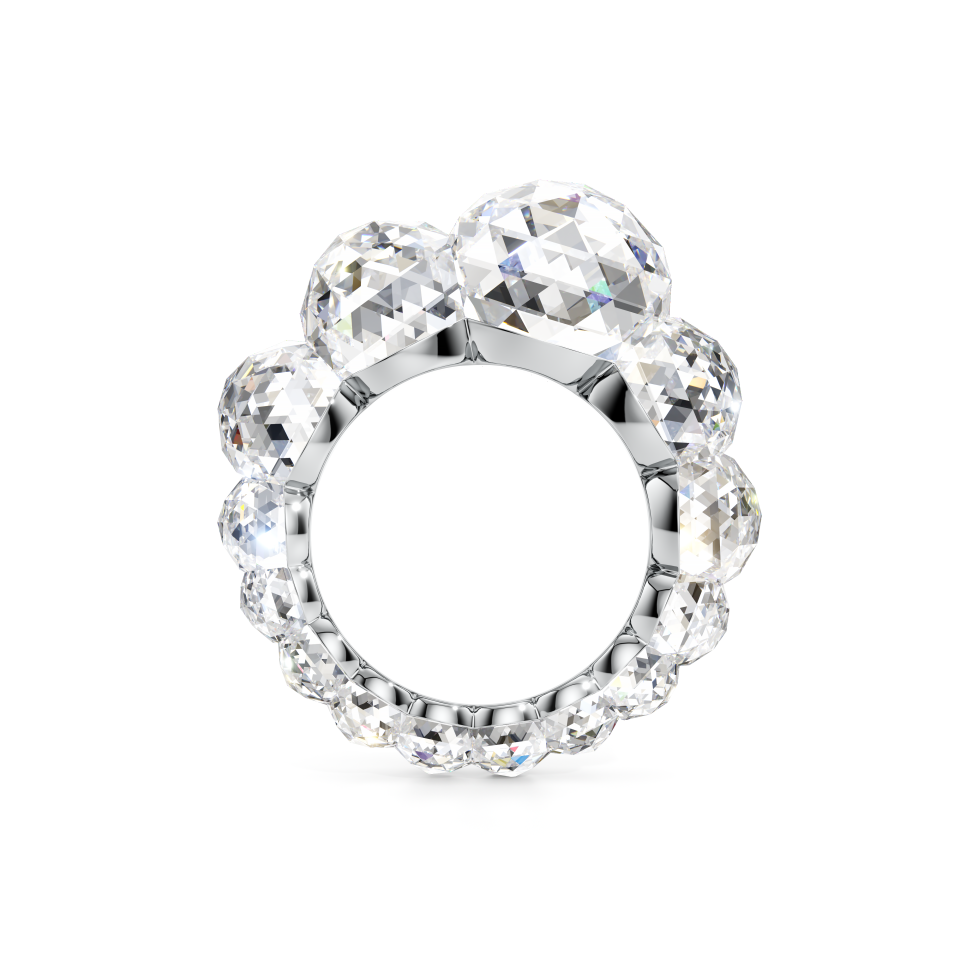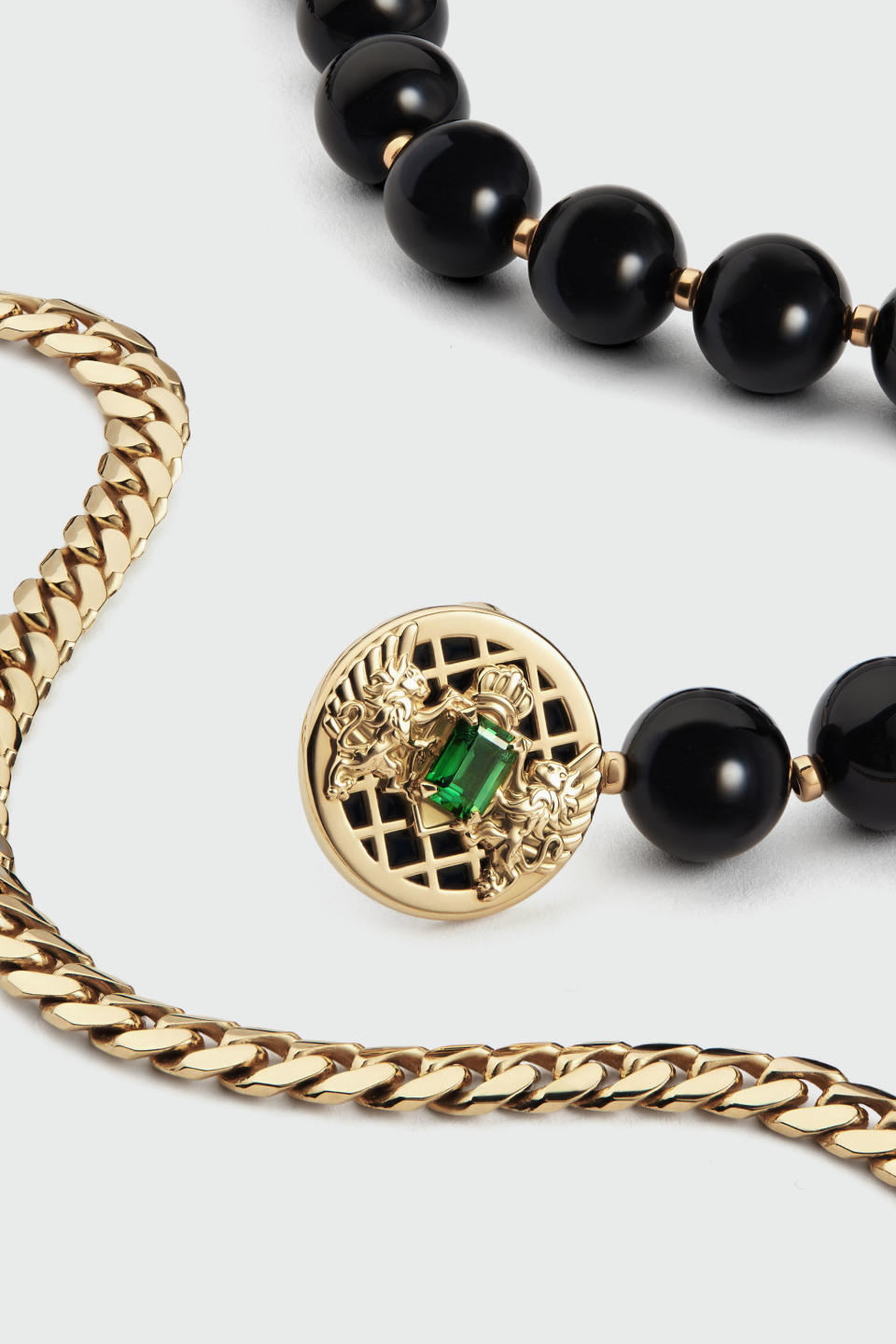Big Stones, Poetic Gestures and a Dash of Fun for Paris’ Jewelry Houses

PARIS — High jewelry may have gotten a taste of destination events but when it comes to showing its biggest and boldest designs — and stones —there is no place like its historic home: Place Vendôme.
Not even the long shadow of COVID-19 and upticks of Omicron variants around the world could dim the gleam of gemstones earlier this month as houses big and small drew bold-face names, clients and international editors to their showcases.
More from WWD
Given the number of “reserved” notices that peppered presentations, buyers certainly rose to the occasion.
Take Chanel’s “Allure Céleste” necklace, the centerpiece of the “1932” anniversary collection. Before the high jewelry presentations officially kicked off, lucky guests in the Grand Palais Éphémère were given one last glance at its 55.55-carat sapphire, one of three celestial motifs surrounded by radiant imprints, before it went to its new owner.
Fortunately, high jewelry creation studio director Patrice Leguéreau expanded the themes of the moon, the sun and the comet into a further 76 designs, many of which included transformable gemset motifs.
“From the start, [movement] was a guideline I followed like the Evening Star. I wanted lightness, I wanted movement, I wanted suppleness, I wanted poetry, too,” he said.
To that end, he worked with a blue diamond, but also rubies, sapphires, tanzanites and a striking trio of blue-black opals — statement stones one and all. But the white and yellow diamond palette of the original “Bijoux de Diamants” yielded the most striking gems in the collection.
At the center of the sun motif of the “Soleil 19 Août” necklace is a 22.1-carat fancy vivid yellow diamond, while a pair of 19-carat white diamonds were the twinned center stones of the stately “Comète Constellation” diamond encrusted collar necklace. To switch things up, they could be swapped with a duo of star motifs and worn on a ring.

Courtesy
While July felt like a return to pre-pandemic splendor, COVID-19’s aftereffects will continue to be felt for the next couple of years, expected Toshikazu Tajima, president and chief executive officer of Tasaki, who was back in Paris for the first time since 2020.
The Japanese high jeweler was presenting “Radiant Sky,” the fifth Atelier high jewelry collection of creative director Prabal Gurung, rife with sizable turquoises that looked like fluffy clouds had brushed their surface, a rainbow of gemstones and, of course, pearls. Inspired by the sky under changeant conditions, it felt like a metaphor for the jewelry industry’s reconfigured business environment.
Although the brand initially lost 30 percent of its sales from inbound tourists, mainly those from China, its domestic market in Japan eventually grew 20 percent — an objective that had been part of its five-year plan set in 2017.
But that’s not to say Tasaki’s overseas business dwindled: business in China doubled in 2021, and its European business, driven mainly by good – “nearly break-even” – results at its store in the Ritz in Paris, also progressed significantly.
In the U.S., where it is present without physical flagships, strides were also made, although Tajima said a flagship was not in the immediate plans as the company focuses on its London store, opened on tony New Bond Street a few months before the 2020 lockdown.
For the first six months of 2022 — Tasaki’s fiscal year is connected to the pearl harvesting season and starts in November — the company saw 26 percent growth at constant exchange rates compared to 2021’s first half. Tajima projected that growth should increase to 30 to 35 percent once tourist sales start to recover.
He credited these good results to strong brand equity and increased customer loyalty, but also to increased interest in the high jewelry segment.
“In order to [make] our operation successful, we really need more high-ticket pieces, [high ticket] customers,” he explained.
Across the board, exceptional stones dominated the high jewelry collections, confirming a trend toward investment pieces, or rather “a stone that keeps its value throughout [a client’s] life, or even generations,” as Chaumet’s CEO Jean-Marc Mansvelt put it.
Even Buccellati, which delved deep into its archives for vintage designs and pieces it has bought back and painstakingly restored, offered up a 74.25-carat aquamarine nestled in the “Deep Light Blue” cuff bracelet’s gold foliage, edged by sinuous lines of brilliant-cut diamonds.
It was one of the highlights of a selection that went all the way back to cocktail rings from the ’50s to ’70s, and a rectangular floral frieze brooch with rose-cut diamonds from the ’40s.
“What interested me and the beauty of it is that when it’s vintage, you know there is only one,” said Maria Cristina Buccellati, the house’s global communication and marketing director and granddaughter of founder Mario.
Likewise, with Taiwanese jeweler Cindy Chao, where her fluttery ruby-encrusted Ribbon brooch and its 76.91 carat old-mine diamond from 2018 nearly overshadowed 2022’s Masterpiece designs: a cuff figuring a sleeve with two yellow cushion-cut diamonds as cuff links, and a windswept tropical leaf finished with a Muzo green Colombian emerald.
Of course, the larger the stone, the more crucial the design.
“The question we always ask ourselves is: how can we showcase these gems to best accentuate their beauty? This might be by presenting them together as a collection of stones or creating a design that serves to celebrate the beauty of a single stone,” said Anne-Eva Geffroy, design director at Graff, whose 80-piece “Graffabulous” collection totaled some 3,600 carats of diamonds, emeralds, sapphires and rubies, including a 109-carat Sri Lankan sapphire and a 22-carat yellow diamond.
After unveiling its annual Red Carpet collection in Cannes, France, Chopard showcased 10 pieces during Couture Week at its Parisian flagship. The setting allowed visitors to get close to the 70-carat pear-shaped fancy light brown-yellow diamond that looks edged in glittering lace — more diamonds, of course — on a three-strand necklace.
A 37.97-carat green tourmaline set on the “Feuillage Diamant” (or “diamond foliage”) aluminum cuff bracelet is one of the standout pieces at Boucheron, where the full “Ailleurs” collection by artistic director Claire Choisne was unveiled through a series of intimate presentations in the house’s Place Vendôme home.
It was among the precious stones that contrasted with humble and fragile materials like rattan, burnt wood and preserved butterfly wings that Choisne turned into extravagant creations inspired by nature.
“King of diamonds” its founder may be, but it was all manners of rubellites, aquamarines, tourmalines and colorful gems that stood out in Harry Winston’s “Majestic Escapes” collection.
If blues dominated this evocation of seaside destinations, the octagonal-cut rubellites — arrayed as neatly as the Amalfi Coast flower beds that inspired it — was certainly worth picking.
On the top floor of the Hôtel de Crillon, De Beers unveiled a second chapter of “Alchemist of Light” and further reached beyond its diamond-centric identity.
Cue the “Ascending Shadows” set and its whorls of blue titanium and aluminum that were assembled, since these metals can’t be welded, through a cunning system that was then hidden with minute diamonds on the back of each element. Black aluminum was likewise the star of the “Optical Wonder” set, with its Vasarely-style Op Art feel.
There were also semiprecious stones like green chiroprase and even rock crystal for the “Frozen Capture” set. However, it wouldn’t be De Beers without some important stones, like the 20.1-carat pear-shaped diamond, one of its Natural Works of Art set of gemstones, that completed this set’s necklace, or the smaller but no less precious 1.13-carat fancy intense pink diamond, starring as a detachable pendant on the transformable “Dusk Reflection” choker that can be separated into two bracelets.
But what really caught the eye was a 111.95 rough stone, discovered in a De Beers mine in Botswana in 2016. It is expected by house experts to yield a “potentially flawless” pear-shaped 50-carat diamond once cut.
Seeing the potential of a rough stone was also at the heart of Messika’s latest collection, where Valérie Messika was inspired by the mythology of ancient Egypt.
The starting point was a 110-carat stone, won by her brother Ilan Messika, at his first tender. She decided to purchase the resulting series of 15 stones, which includes a 33-carat cushion-cut diamond.
It takes pride of place on the Akh-Ba-Ka (three ancient Egyptian words that translate to “soul-personality-vital essence”) necklace, a 2,550-diamond piece that took some 1,000 hours to make.
Anyone wanting to add this piece to their collection should be prepared to purchase the matching earrings and rings. More than a set, Valérie Messika sees the set as a metaphor for her family, “so they should stick together, too,” she said in a salon of the Hôtel de Crillon, which had been turned into an Egyptian temple for the occasion.
While cutting the important stones of a collection from a single rough certainly makes for a striking story, there is another reason why this captures the attention of jewelry houses.
“Because of the nature of diamonds, it’s impossible to trace back the origin from a polished stone,” said Van Cleef & Arpels’ CEO Nicolas Bos.
“It’s not so much reacting to expectations or constraints, it’s really that we are in a world [where] it makes more and more sense to be [as] open and transparent as we can,” he continued.
So when the house was offered the 910-carat rough Lesotho Legend diamond, named after its country of origin, the prospect felt irresistible. It became part of a project that involved Van Cleef working alongside the mine, the Antwerp-based cutting experts in Antwerp, and even the GIA, resulting in 67 diamonds with a certified provenance.
“It [was] interesting, because I’m not sure it’s going to work for 100 percent of diamonds in the future. But more and more, this is the type of philosophy and the type of flows that we are trying to organize and support,” Bos noted.
But this was only an interesting aside, since the idea was always to build “a collection of jewelry, not of stones,” he added.
These diamonds have therefore been distributed across the “25 Mystery Set Jewels” of the first chapter of the Legend of Diamonds collection, which amply uses the house’s mystery setting that gives stones pride of place.
Among the most striking were the ruby and diamond “Atours Mystérieux” (or mysterious adornments) necklace and its 79.35-carat oval diamond, which can be worn separately; the graphic sapphire, emerald and diamond “Chevron Mystérieux” with its trio of detachable pendants, and another diamond-and-ruby knotted ribbon one that can be taken apart to be worn as a pair of earrings, a river of diamonds or a deceptively simple pendant, among other options.
This love letter to diamonds continued in the second “White Diamond Variations” chapter, which meanders through various eras, taking cues from a Renaissance collar, the geometric designs of the Roaring ’20s or the perennial fascination of jewelers for the suppleness of textiles. As a finishing touch, the oft-overlooked clasps were here worked as ornamental designs in their own right.
No matter how precious, wit in design is also a must, according to Mansvelt. Talking about the “Ondes et Merveilles” collection, which included poetic evocations of water currents and mermaids alongside aerial views of the shore or sailor tattoos, he said they “had fun.”
“A collection should be joyous. That’s a side that is important to me, these little side steps, this playfulness that [balances out] being a major high jeweler, being very ancient, very serious and doing the very beautiful but expected designs befitting a high jeweler,” the Chaumet CEO continued, noting that these more humorous pieces opened the door to “another public” that could include male clients, despite the fact that “it wasn’t [Chaumet’s] destiny to work men in high jewelry.”
Likewise at Anna Hu, a 55-carat heart-shaped Moussaieff diamond or a 265-carat rubellite might be the center of two of her “Enchanted Lily” brooches, but it’s the unexpected delight of finding delicate pink diamonds in the curl of a petal or glow-in-the-dark luminescent pistils that makes them, well, shine.
Asked why shadows struck his fancy more than jewels, Hermès creative director for fine jewelry Pierre Hardy said with a laugh that it was by “spirit of contradiction.”
“High jewelry is a very codified world, normed by value, by size,” he explained. This triggered a desire to look at the effect these precious designs could produce, and he noticed that “the more you show the shadow, the more you show the stone.”
Hardy therefore recast traditional stone cuts and “near historic” shapes into graphic impressionist interpretations: a golden whip with a glittering blue imprint; the house’s “Chaîne d’Ancre” supplemented by inky duplicates; rings with rough-cut stones sitting on matching pavé-set pools, or rows of green gems appearing to float, connected only by their slate gray shadows outlined in gold.
Dior, Louis Vuitton and Bulgari were among the houses that did not show in Paris, having unveiled their collections through destination events and, in the case of the Italian label, a gala evening in Paris attended by Priyanka Chopra, Anne Hathaway and Blackpink singer Lalisa Manobal.
After traveling to Madrid with Jisoo and Yara Shahidi in June, Cartier took over the winter garden of the Ritz to unveil a further 47 pieces in the second chapter of its “Beautés du Monde” (“Beauties of the World”) collection, including the stunning “Ryu” set, featuring yellow diamonds cut into a double-pyramid shape that echoed the natural shape found in uncut roughs.
At Pomellato, creative director Vincenzo Castaldo imagined a summer day from first light to the depth of night in “A Walk in Nature: From Sunrise to Darkness,” the third “La Gioia” high jewelry collection.
Speaking of daily, that’s exactly what CEO Sabina Belli imagined for these jewels, meant to “bring joy on an everyday situation,” especially the “Summer Storm” suite and its transformable necklaces.
“I would hate to know that a consumer of ours has a piece in a vault, sitting there [and] waiting for the occasion,” she said.
Sharp turn
The competition between natural diamonds and their lab-grown counterparts is heating up:
• Antwerp-based fine jewelry brand Unsaid took over the Ritz’s Salon d’Été to unveil its latest designs. The star of the show was the 39.5-carat Reminiscence ring, composed of a graduated series of bubble-cut diamonds. Each of the 14 stones, going from one to 9.4 carats, was grown thanks to solar energy to power the chemical vapor deposition, or CVD, machines.
• For Louise de Rothschild and Keagan Ramsamy, cofounders of newly minted high jewelry house Mazarin, “each decade comes with a new technique and lab-grown diamonds are a resource of our time,” the pair said during an appointment at their new Faubourg-Saint-Honoré showroom. They set their European-made gems, including colored diamonds, in ethical gold designs inspired, for now, by elephants and their symbolism.

Courtesy of Unsaid
So far, so fine
Just before Olivier Rousteing unveiled his designs for Jean Paul Gaultier, Balmain revealed its first fine jewelry designs. The Emblem line takes its cues from the house’s blazon and Rousteing’s seminal 2012 collection, inspired by Fabergé eggs, while the Labyrinth range revisits a repetitive frieze motif inspired by the intricate mazes of Renaissance gardens, using the initials of house founder Pierre Balmain. The 20-or-so designs are made with ethical recycled 18-karat gold and traceable gemstones.

Courtesy of Balmain
Launch Gallery: High Jewelers Go Big And Bold This July
Sign up for WWD's Newsletter. For the latest news, follow us on Twitter, Facebook, and Instagram.

